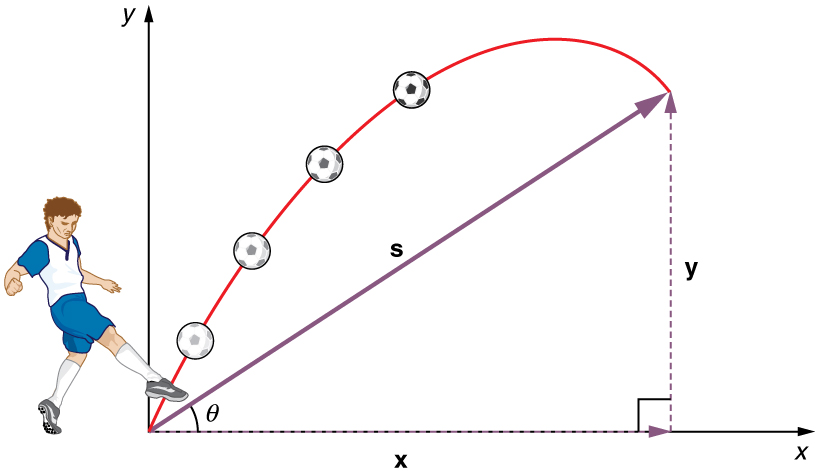Imagine you’re driving to a friend’s house. You take a few wrong turns, backtrack a bit, and eventually make it to their doorstep. You traveled a certain distance, but did you actually change your position from where you started? This simple scenario highlights a crucial difference between two fundamental concepts in physics: distance and displacement. Understanding these concepts helps us to accurately describe and analyze motion, not just in cars, but also in the intricate world of particles, planets, and anything else that moves!

Image: phys.libretexts.org
Distance and displacement are both measurements related to motion, yet they offer distinct perspectives on how an object changes its position. Distance is a scalar quantity, meaning it only considers the magnitude (how much) of the path traveled. Displacement, on the other hand, is a vector quantity, taking into account both magnitude and direction. In this article, we’ll delve deeper into these concepts, exploring their definitions, applications, and the subtle differences that make them crucial to understanding the world around us.
Distance and Its Role in Describing Motion
Simply put, distance is the total length of the path traveled by an object. Think of it as the odometer reading in your car – it accumulates the total distance covered, regardless of the route taken. To illustrate, imagine you take a walk around a rectangular park. You walk 100 meters east, then 50 meters north, then 100 meters west, and finally 50 meters south to return to your starting point. The total distance you’ve covered is 300 meters (100 + 50 + 100 + 50 = 300). This is the path you physically walked, regardless of where you ended up.
Distance is valuable in many everyday scenarios. We use distance to calculate fuel consumption, plan trips, and even estimate exercise goals. In physics, distance is often used to calculate speed, which is the rate of change of distance over time. For instance, if you travel 60 kilometers in one hour, your average speed is 60 kilometers per hour.
Displacement: A Vector Perspective on Motion
Displacement, in contrast, measures the overall change in position from the starting point to the ending point. It’s not concerned with the path taken, but with the straight-line distance between the initial and final positions. Using our park example, your displacement would be zero because you returned to your starting point. You walked 300 meters, but ended up exactly where you began, leading to a net displacement of zero.
Displacement is a vector quantity, which means it has both magnitude and direction. In our park example, we could represent the displacement with an arrow pointing from the starting point to the ending point. The length of the arrow represents the magnitude (in this case, zero), and the direction indicates the change in position relative to the starting point.
Displacement is crucial for understanding motion in physics, especially when dealing with concepts like velocity, which is the rate of change of displacement over time. Velocity, unlike speed, takes direction into account. A car traveling at 60 kilometers per hour north has a different velocity than a car traveling at 60 kilometers per hour south, even though their speeds are the same.
Distinguishing Distance and Displacement: Key Differences
Let’s summarize the key differences between distance and displacement:
- Distance is a scalar quantity, only considering the total path length.
- Displacement is a vector quantity, considering both magnitude and direction.
- Distance is always a positive value as it measures the total path length.
- Displacement can be positive, negative, or zero depending on the direction of movement relative to the starting point.

Image: quizzmagickatrin.z13.web.core.windows.net
Applications of Distance and Displacement: Beyond the Textbook
These seemingly abstract concepts are invaluable in understanding a wide range of phenomena, from everyday movement to complex scientific models. Here are some examples:
Navigation and Mapping
Mapping apps and GPS systems rely heavily on distance and displacement calculations. When you enter your destination, these applications use algorithms to determine the shortest distance (or sometimes the fastest route) and provide directions. This involves calculating distances between points, accounting for detours, and ultimately using displacement to guide you to your target location.
Sports and Athletics
Athletes and coaches consistently utilize distance and displacement to analyze and optimize performance. In track and field, measuring distance helps calculate speed, while understanding displacement helps analyze running techniques and strategy. For instance, in a long jump, an athlete’s displacement is the horizontal distance covered, while the distance they actually jump is determined by the total length of their trajectory.
Robotics and Autonomous Systems
Robots and autonomous systems heavily depend on accurate distance and displacement measurements. These systems use sensors to perceive the environment, calculate the distance to objects, and plan their movements without human intervention. In autonomous vehicles, for example, understanding displacement is crucial for self-driving features like lane keeping, path planning, and collision avoidance.
Astronomy and Cosmology
Astronomers use distance and displacement to study the vast universe. Calculating the distance between stars and galaxies helps us understand the universe’s scale and structure. And by observing the displacement of stars and galaxies over time, astronomers can infer their motion and ultimately deduce the expansion of the universe.
Describing Motion Verbally With Distance And Displacement
https://youtube.com/watch?v=Vo2S_o3Hah4
Conclusion
Understanding the difference between distance and displacement is fundamental for comprehending motion in the physical world. While distance simply measures the total length traveled, displacement considers the change in position relative to the starting point. These concepts, often intertwined, have applications across many disciplines, from navigation to sports to advanced scientific research. So, the next time you set out on a journey, whether it’s driving, walking, or exploring the cosmos, remember the power of distance and displacement to reveal the intricate dance of motion around us!






